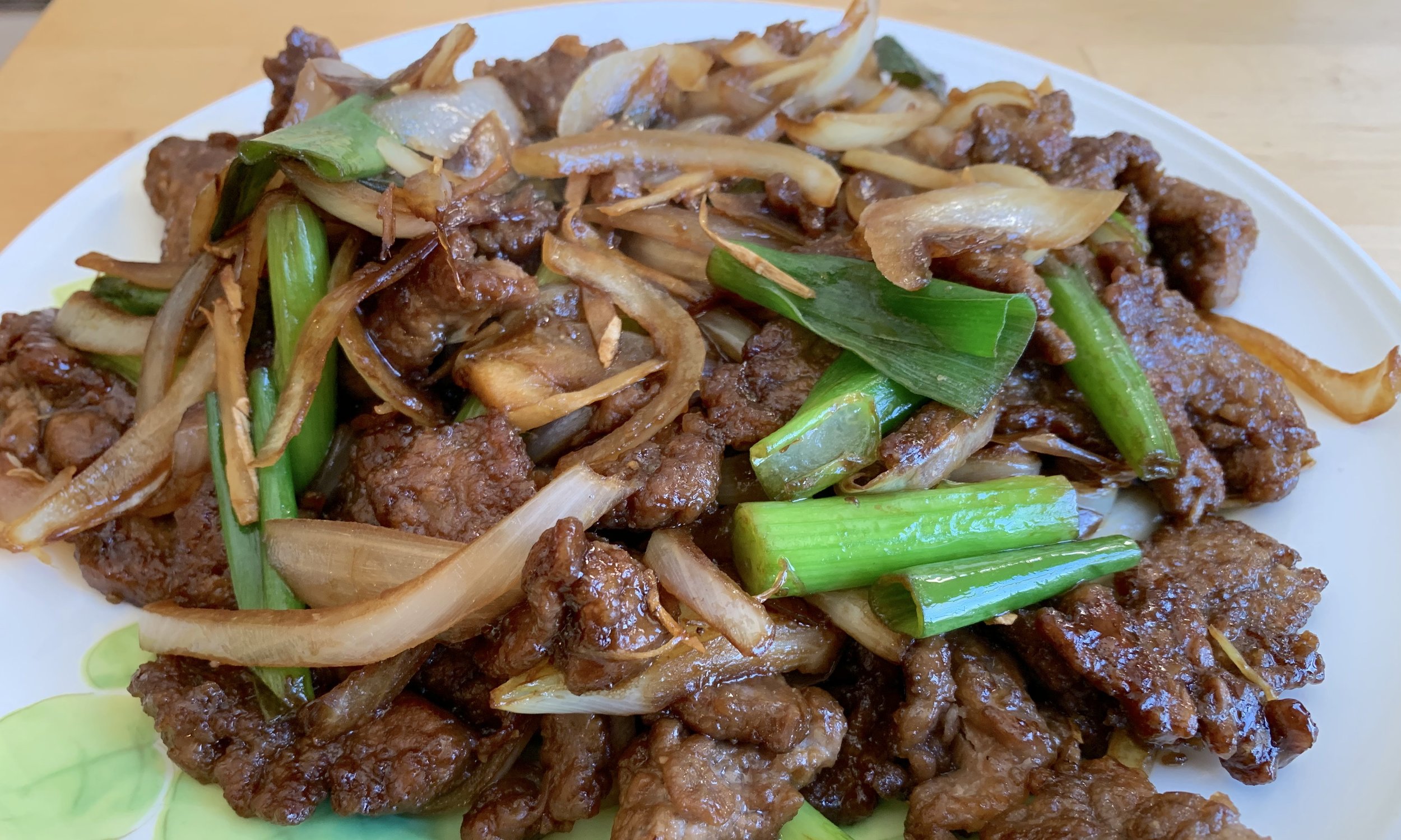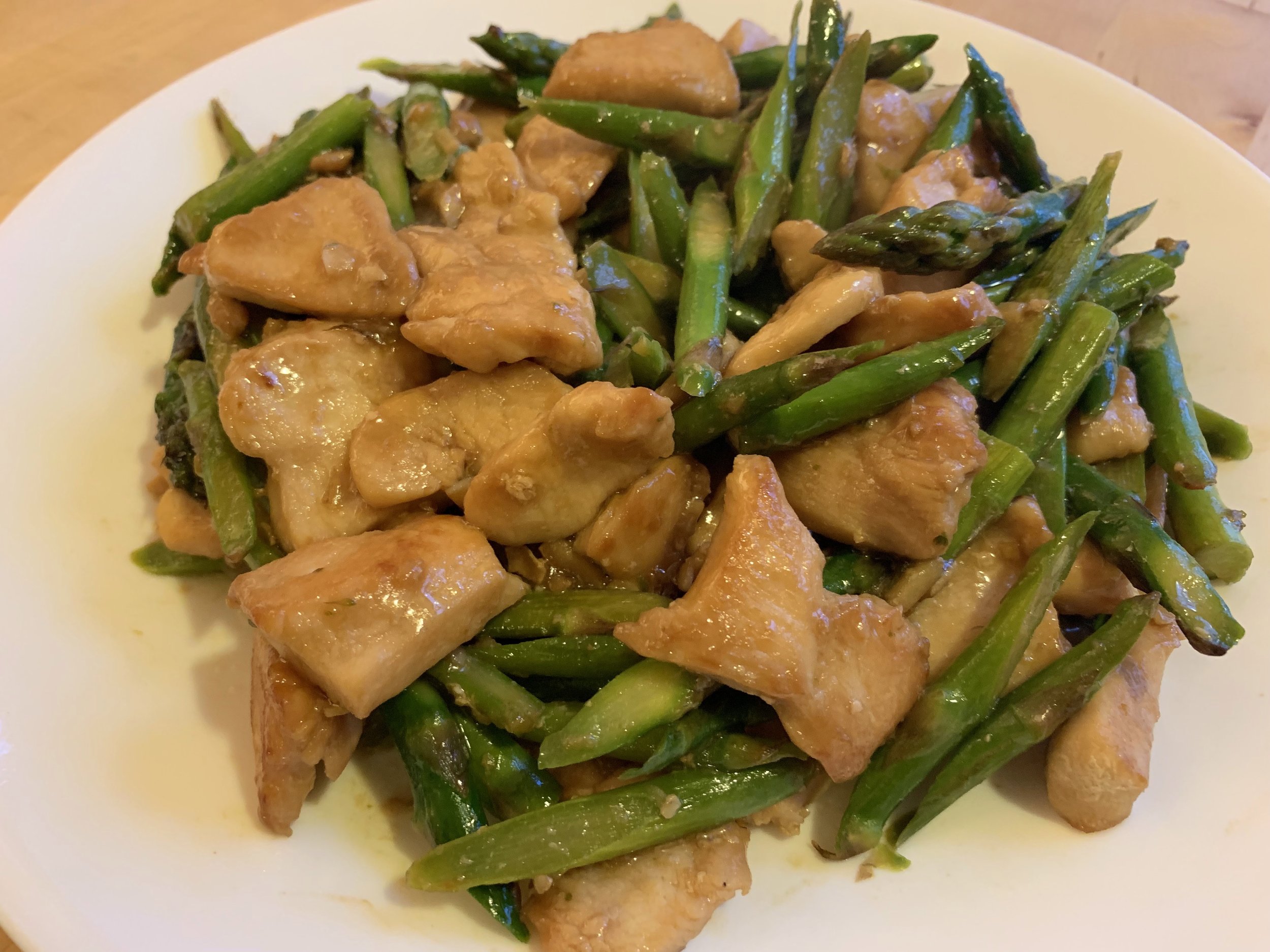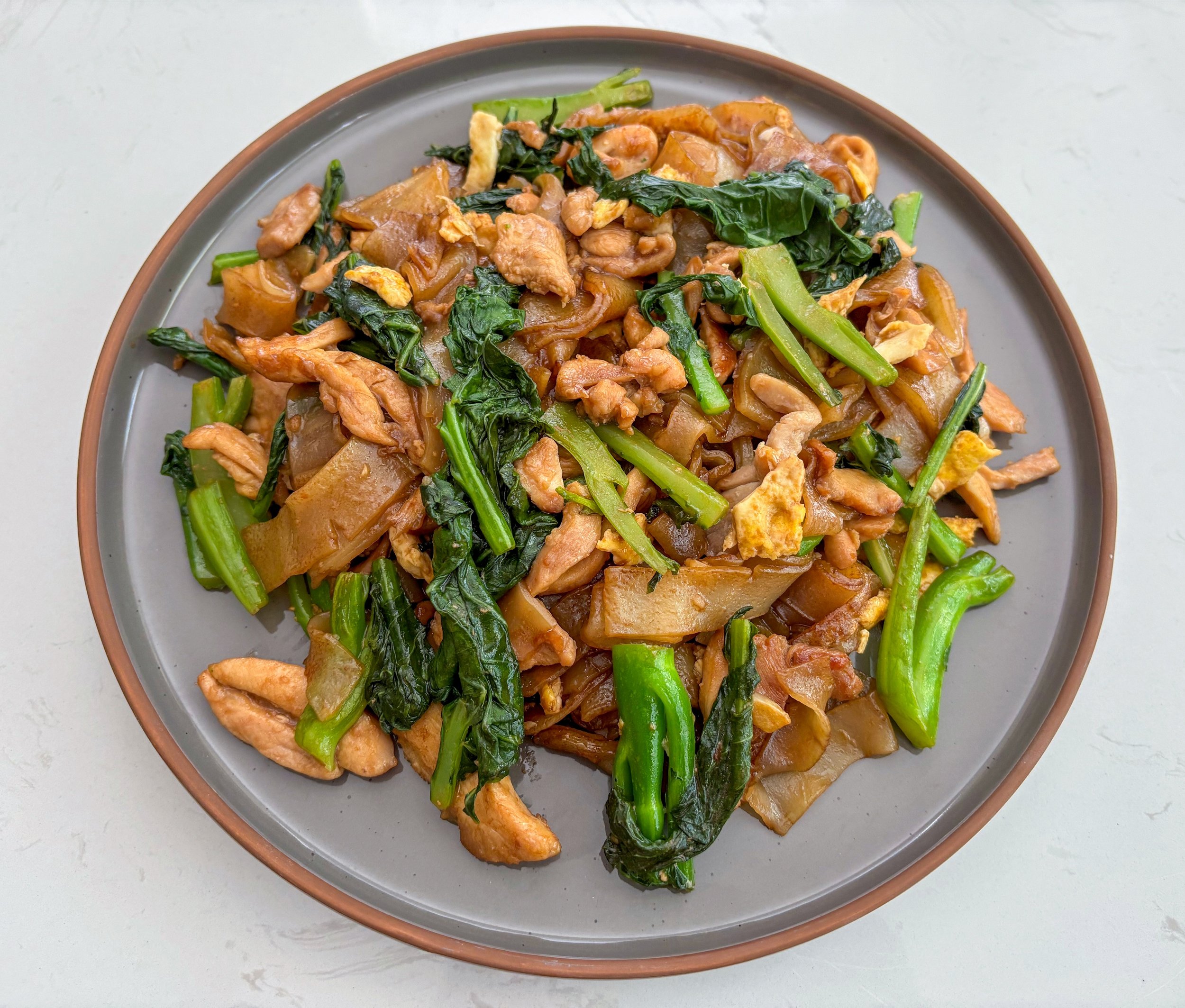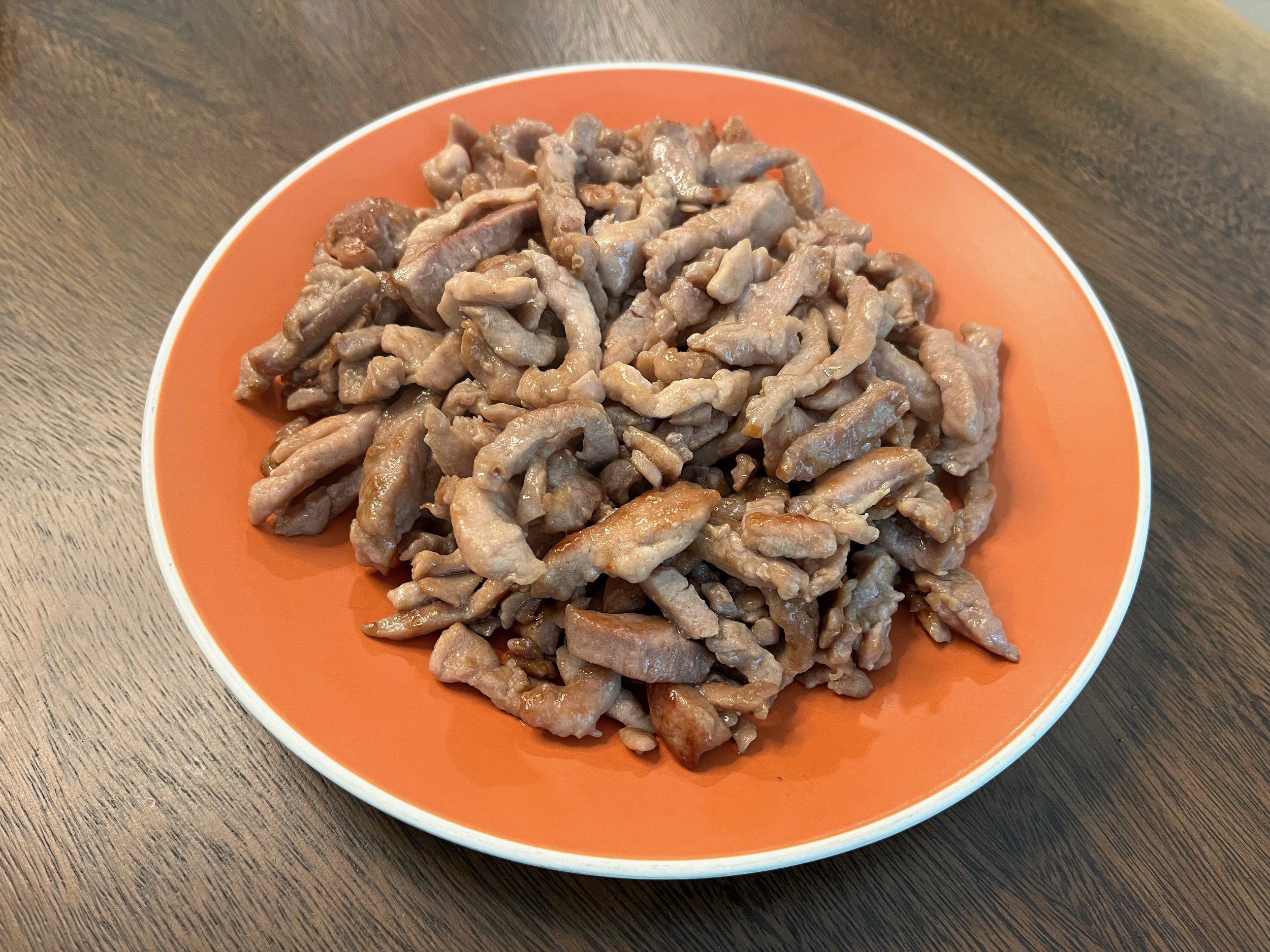Kung Pao Chicken
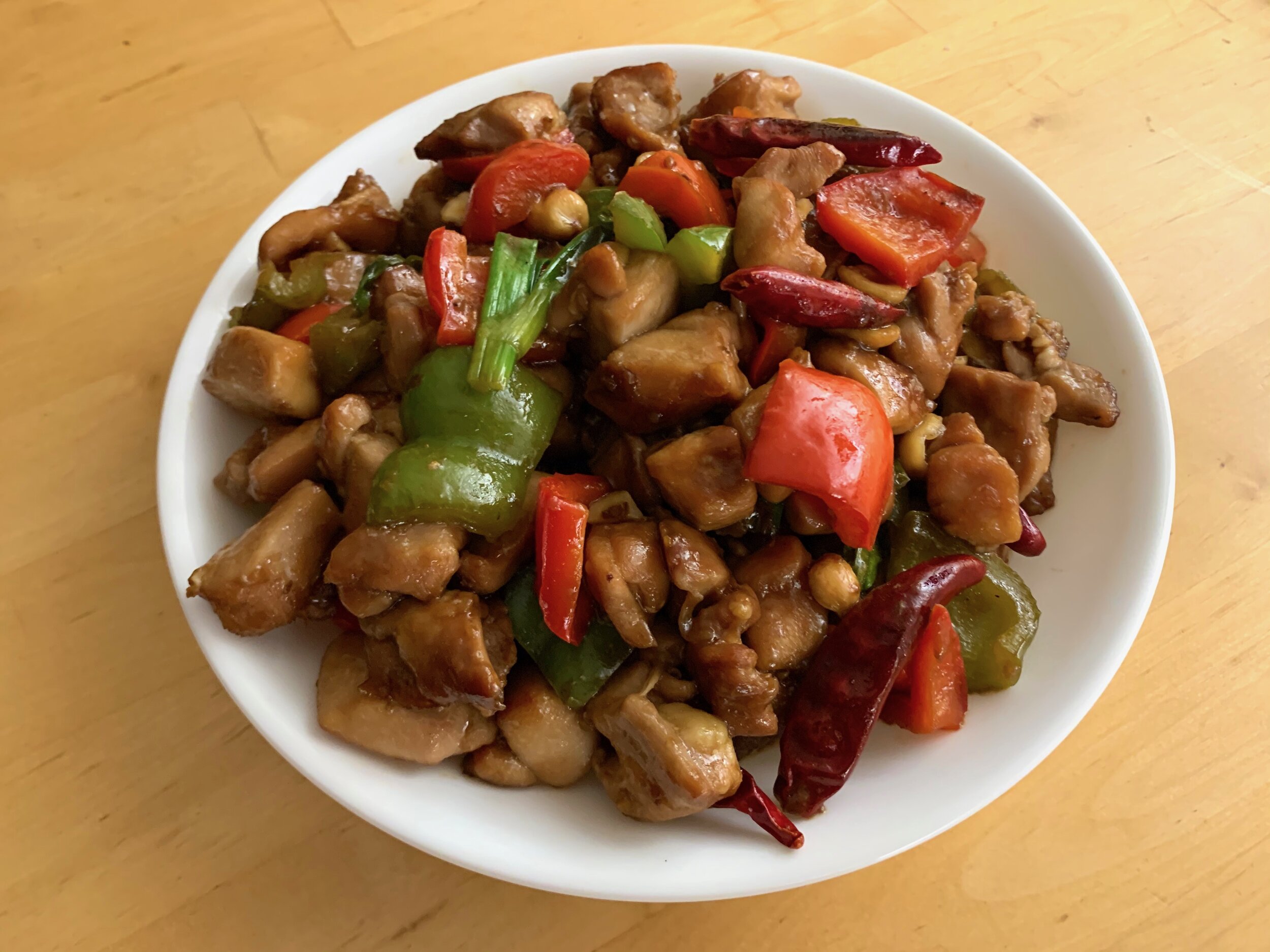
宮保雞丁 (Gong Bao Ji Ding)
Kung Pao chicken is a spicy stir-fried chicken dish originating in Sichuan Province in Southern China. Most common variations found outside Sichuan are less spicy, and include a variety of vegetables. The dish is named for the governor of Sichuan in the late 1800s, Ding Baozhen [1], though it occasionally goes by other names [2]. Popularized in the West by takeout restaurants, Kung Pao chicken is a relatively simple stir-fry to prepare at home.
Ingredients
1 lb boneless skinless chicken breasts
2 tsp soy sauce
½ tsp white pepper
3 tsp cornstarch
4 cloves garlic, minced
1 inch ginger, minced
1 tsp Sichuan peppercorns (optional)
6 dried red chilies
2 bell peppers, chopped
5 scallions, chopped
1 cup roasted peanuts
2 tbsp vegetable oil
1 tbsp dark soy sauce
1 tbsp Chinkiang vinegar
1 tbsp Shaoxing rice wine (optional)
1 tsp brown sugar
1 tsp sesame oil
salt to taste
As with all true stir fries, the name of the game is heat management. We want to cook all of the ingredients with dry heat, rather than boiling the ingredients in liquid. Additionally, we are cooking chicken breast, a very lean meat, and cooking a lean meat under high heat means a small time window of optimal doneness between undercooked and overcooked. All of the preparatory steps are geared to maximize our chances of success.
Let us begin by cutting the chicken into ¾ inch cubes. It is important to keep the size of the pieces consistent, so that they will cook in the same amount of time. Mix the chicken pieces with soy sauce, white pepper, and two teaspoons of cornstarch, and set aside for 20 minutes. If you are pressed for time, you can reduce this time, but if you choose to do so, be more vigilant about overcooking.
This quick marinade serves several purposes beyond flavoring the chicken. Overcooked chicken breast becomes dry, tough, and stringy. The marinade will help us avoid this fate by giving us a bit of a safety net. The salt in the soy sauce will help the chicken retain moisture, while the cornstarch will assist in browning, protect the surface of the chicken from cooking too quickly, and help the sauce cling to the meat.
This dish is traditionally prepared very quickly in a wok on very high heat. On conventional stovetops this is difficult to achieve, largely because even if you have a wok, western stovetops don’t produce the same jet-engine levels of power as Chinese burners.[3] To get around this problem, we will be using a large skillet, and cooking our ingredients in series.
Due to the time-sensitive nature of stir-fries, it is one of the few types of preparations for which I recommend a thorough mise en place, with all ingredients prepared and ready for the heat before the cooking starts. While the chicken is marinading, mince the garlic and ginger. Chop the scallions into 1 inch pieces, and chop the bell peppers into 1 inch squares. As with the chicken, uniformity will help us ensure even cooking. Let us also take the time to premix our finishing sauce, combining the dark soy sauce, Chinkiang vinegar, Shaoxing rice wine, brown sugar, and 1 teaspoon of cornstarch.
When the chicken is done marinading, heat a tablespoon of oil in a large skillet over high heat. When the oil is hot, add the chicken to the skillet and fry. Be sure to avoid overcrowding the pan—the chicken should form a single layer with comfortable space in between. If your pan is too small to do this, cook the chicken in batches. Leave the chicken alone for about a minute to help brown the first side of the meat. Then, toss the chicken pieces to cook the other sides (Try to flip most of them, but it’s not the end of the world if you don’t get them all). Continue tossing occasionally until the exterior of the chicken pieces is mostly browned, about two or three minutes total. Remove the chicken pieces from heat and put them into a clean bowl. These pieces are still raw in the middle, so no snacking!
Return the skillet to heat and add another tablespoon of oil. Once the pan is hot again, add the bell peppers. The same rules apply for the peppers as for the chicken—form a single layer, and keep the temperature of the pan high. We want to minimize the amount of water the vegetables release as they cook. Cook for two minutes, stirring occasionally. The peppers should still be crisp at this point, just starting to soften.
Form a well in the middle of the skillet and introduce the aromatics to the heat—the minced garlic, ginger, chilies, and scallions. If you are using whole Sichuan peppercorns, this is the time to introduce them to the heat.[4] Stir until fragrant, approximately 30 seconds. Then add the partially cooked chicken back to the skillet, along with the peanuts, and stir to combine. Give the sauce mixture a stir—the cornstarch and brown sugar may have settled, and once it is smooth, add it to the skillet and toss the ingredients to coat. Continue cooking until the chicken is cooked through—about two minutes.
If we have done our job correctly, the sauce mixture has combined with the inevitable small amounts of moisture released by the other ingredients to form a small amount of glossy sauce—just enough to coat the ingredients while leaving the pan more or less dry. Depending on the strength of your burner, freshness of your vegetables, and the local humidity, you may have to adjust the thickness of the sauce on the fly, either adding more cornstarch slurry or letting the sauce down with small amounts of water.
Once the chicken is cooked through, stir in the sesame oil, remove the dish from heat, and serve.
Substitutions
The spice level of this preparation is fairly mild, fragrant but not fiery. You should adjust the number of chilies to your taste, from zero to the handfuls used in the traditional Sichuan version. Slicing the dried chilies will also up the heat. If you cannot fined dried chilies, you can substitute red chili flakes or chili garlic sauce.
The traditional Sichuan version does not include vegetables—if you wish to prepare this version, skip the bell peppers and don’t remove the chicken from the pan. If you prefer a sweeter, more “American takeout” taste to this dish, increase the amount of brown sugar and vinegar.
This dish is fairly flexible when it comes to vegetable additions, as long as they are quick cooking and have a relatively low moisture content. Vegetables which work well in addition to or in place of bell peppers include onions, carrots, and celery.
This dish works well with chicken thighs, though you will have to cook them for slightly longer.
If you can’t find Chinkiang vinegar, you can use rice wine vinegar or balsamic vinegar as a substitute.
[1] Ding Baozhen was the tutor of the Crown Prince, and in this capacity he earned the nickname “Gongbao” (宫保), which translates to “Palace Guardian.”
[2] Due to Ding Baozhen’s association with the Qing Dynasty, the name of the dish was declared politically incorrect by the Chinese Communist Party during the Cultural Revolution. Other names were proposed for the dish instead, such as “chicken with hot peppers” (糊辣鸡丁). The original name wasn’t brought back to mainland China until the reforms of Deng Xiaoping in the 1980s.
[3] If you really are committed to doing real wok frying at home, the closest you can get is using the wok over a charcoal grill, cooking with direct heat. But that’s a lot of work.
[4] If you are using ground Sichuan pepper, hold off on adding it until the dish is done—stir it in with the sesame oil at the end. Adding it to direct heat too early will cause it to burn, creating bitter notes in the dish and probably a fair bit of unpleasant smoke.
Recipe
Prep Time: 10 min Cook Time: 10 min Total Time: 30 min
(+10 min inactive)
Difficulty: 2/5
Heat Sources: 1 burner
Equipment: skillet
Servings: 6
Ingredients
For the Chicken
1 lb boneless skinless chicken breasts
2 tsp soy sauce
½ tsp white pepper
2 tsp cornstarch
For the Stir-Fry
4 cloves garlic, minced
1 inch ginger, minced
1 tsp Sichuan peppercorns (optional)
6 dried red chilies
2 bell peppers, chopped
5 scallions, chopped
1 cup roasted peanuts
2 tbsp vegetable oil
For the Sauce
1 tbsp dark soy sauce
1 tbsp Chinkiang vinegar
1 tbsp Shaoxing rice wine (optional)
1 tsp brown sugar
1 tsp cornstarch
1 tsp sesame oil
salt to taste
Instructions
1. Cut chicken into ¾ inch cubes, mix chicken with the soy sauce, white pepper, and cornstarch, and set aside for 20 minutes.
2. While the chicken is marinating, mince the garlic and ginger, chop the bell peppers into 1 inch pieces, and chop the scallions into 1 inch pieces.
3. Prepare the sauce by mixing the dark soy sauce, vinegar, rice wine, brown sugar, and cornstarch.
4. In a large skillet, heat one tablespoon of oil on high heat. When the oil is hot, add the chicken and cook for 2-3 minutes, until the exterior has browned. Remove the partially cooked chicken from heat.
5. Add the second tablespoon of oil to the skillet, let it come up to temperature, and add the bell peppers, and cook for 2 minutes.
6. Add the garlic, ginger, dried chilies, Sichuan peppercorns, and scallions to the skillet and stir for 30 seconds, until fragrant.
7. Return the chicken to the skillet, add the peanuts, and toss to combine.
8. Add the sauce mixture to the skillet and stir. Cook until the chicken is cooked through, approximately 2 minutes, adding water if necessary to the sauce.
9. Stir in the sesame oil, remove from heat, and serve.










